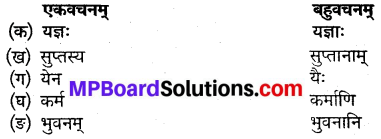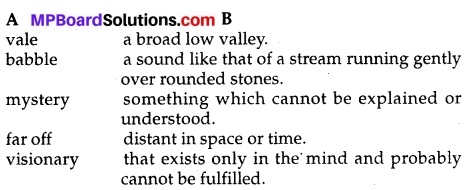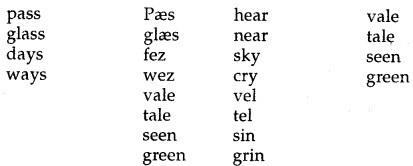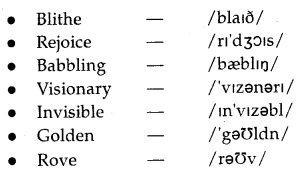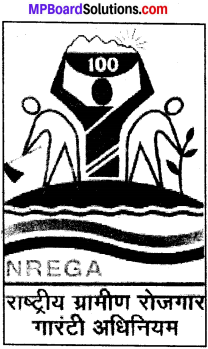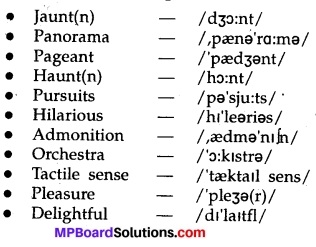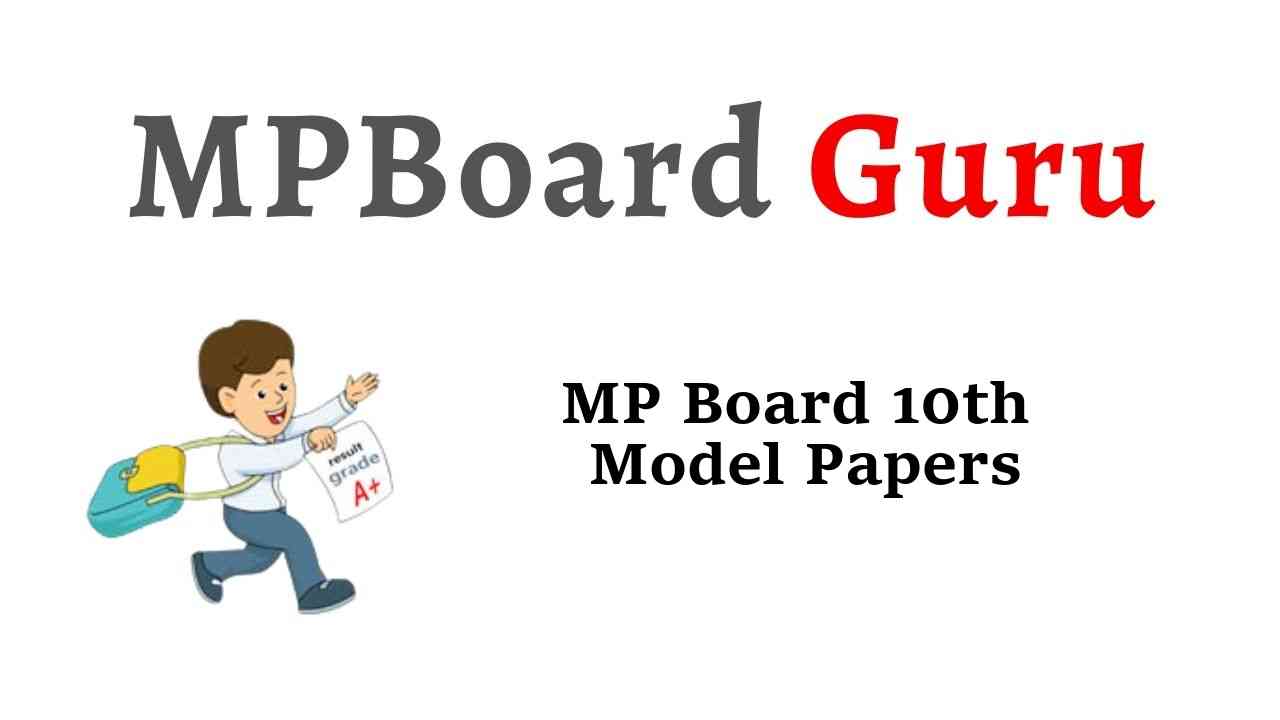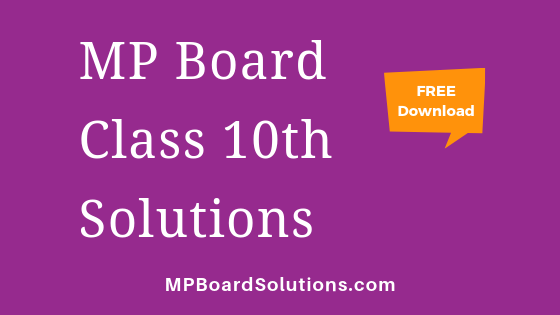MP Board Class 10th Sanskrit Solutions Durva Chapter 11 महाभिनिष्क्रमणम् (नाट्यांशः) (वाल्मीकिरामायणतः)
MP Board Class 10th Sanskrit Chapter 11 पाठ्यपुस्तक के प्रश्न
कक्षा 10 संस्कृत पाठ 11 MP Board प्रश्न 1.
एकपदेन उत्तरं लिखत-(एक पद में उत्तर लिखिए)।
(क) का रूपं नाशयिष्यति? (कौन रूप को नष्ट करेगा?)
उत्तर:
जरा। (बुढ़ापा ।)
(ख) सिद्धार्थः कस्य पुत्रः आसीत्? (सिद्धार्थ किसका पुत्र था?)
उत्तर:
शुद्धोदनस्य। (शुद्धोदन का)
(ग) धरा कस्य पत्नी आसीत? (यशोधरा किसकी पत्नी थी?)
उत्तर:
सिद्धार्थस्य। (सिद्धार्थ की)
(घ) सिद्धार्थस्य पुत्रः कः आसीत्? (सिद्धार्थ का पुत्र कौन था?)
उत्तर:
राहुलः। (राहुल)
(ङ) सिद्धार्थ : कस्मिन् वंशे उत्पन्नः अभूत्? (सिद्धार्थ किस वंश में पैदा हुआ था?)
उत्तर:
शाक्यवंशे। (शाक्यवंश में)
Class 10 Sanskrit Chapter 11 MP Board प्रश्न 2.
एकवाक्येन उत्तरं लिखत-(एक वाक्य में उत्तर लिखिए)
(क) कस्य अभिनिष्क्रमणसंस्कारः अस्ति: (किसका अभिनिष्क्रमण संस्कार है?)
उत्तर:
कुमार राहुलस्य अभिनिष्क्रमणसंस्कारः अस्ति। (कुमार राहुल का अभिनिष्क्रमण संस्कार है।)
(ख) सिद्धार्थः अनुज्ञां प्राप्तुं कस्य समीपं गतः? (सिद्धार्थ आज्ञा गप्त करने किसके पास गए थे?)
उत्तर:
सिद्धार्थः अनुज्ञां प्राप्तुं शुद्धोदनस्य समीपं गतः। (सिद्धार्थ आज्ञा लेने के लिए शुद्धोदन के पास गया था।)
(ग) सिद्धार्थः केषु नानुरञ्ज्यति? (सिद्धार्थ किससे खुश नहीं हो रहा था?)
उत्तर:
सिद्धार्थः नृत्यसङ्गीत-वादित्रेषु नानुरञ्जयति। (सिद्धार्थ नृत्य-संगीत-वाद्य आदि में खुश नहीं हो रहा था।)
(घ) वयं मनुष्याः कां जानन्तोऽपि न शोचामः? (हम लोग किसको जानते हुए भी नहीं सोचते?)
उत्तर:
वयं मनुष्याः प्रतिदिनं ग्रसन्ती मृत्युराक्षसीं जानन्तोऽपि न शोचामः। (हम लोग प्रतिदिन खाती हुई मृत्यु रूपी राक्षसी को जानते हुए भी नहीं सोचते हैं।)
(ङ) मनुष्यस्य यौवनं विलासश्च कदा शोभते? (मनुष्य का यौवन और विलास कब शोभा देते हैं?)
उत्तर:
जरां व्याधिं मृत्युं च विजित्यैव मनुष्यस्य यौवनं विलासश्च शोभते। (बुढ़ापा, रोग और मृत्यु को जीतकर ही मनुष्य का यौवन और विलास शोभा पाते हैं।)
Mp Board Class 10 Sanskrit Chapter 11 प्रश्न 3.
अधोलिखितप्रश्नानाम् उत्तराणि लिखत-(नीचे लिखे प्रश्नों के उत्तर लिखिए)
(क) यशोधरा तारस्वरेण सिद्धार्थं किम् उक्तवती? (यशोधरा ने ऊँचे स्वर में सिद्धार्थ को क्या कहा?)
उत्तर:
यशोधरा तारस्वरेण सिद्धार्थं उक्तवती यत्-“कुत्र प्रयातिः कुमारः?” इति। (यशोधरा ने ऊँचे स्वर से सिद्धार्थ को कहा कि-कुमार, आप कहाँ जा रहे हैं।”)
(ख) सिद्धार्थः किमर्थं लोकयात्रातः व्यरञ्ज्यत? (सिद्धार्थ क्यों लोकयात्रा पर जाना चाहता था?)
उत्तर:
सिद्धार्थः संसारस्य निःसारता, जनन-मरण-चक्रस्य बन्धनं, मानुषी गतिः, सर्वमिदं विचिन्त्य लोकयात्रातः व्यरज्यत।
(सिद्धार्थ, संसार की सारहीनता, जन्म-मरण के चक्र का बन्धन, मानुषी गति, इन सब को सोचकर लोकयात्रा पर जाना चाहता था।)
(ग) मनोज्ञेषु विषयेषु रतिविषये सिद्धार्थः शुद्धोदनं किम् अकथयत्? (मन के विषयों पर रति के विषय में शुद्धोदन ने क्या कहा?)
उत्तर:
मनोज्ञेषु विषयेषु रतिविषये सिद्धार्थः शुद्धोदनं अकथयत् यत्-“जरा व्याधिश्च मृत्युश्च यदि न स्युः तर्हि मम मनोज्ञेषु विषयेषु रतिर्भवेत्? (मन के विषयों पर रति के विषय में सिद्धार्थ ने शुद्धोदन से कहा कि-“बुढ़ापा, रोग और मृत्यु यदि न हों तो मेरे मन में विषयों पर रति होगी
Sanskrit Class 10 Chapter 11 MP Board प्रश्न 4.
शुद्धवाक्याना समक्षम् ‘आम्’ अशुद्ध वाक्यानां समक्षम् ‘न’ इति लिखत- (शुद्ध वाक्यों के सामने ‘आम्’ तथा अशुद्ध वाक्यों के सामने ‘न’ लिखिए-)
(क) शुद्धोदनः राहुलस्य पिता असीत्।
(ख) यशोधरा राहुलस्य माता आसीत्।
(ग) सिद्धार्थः प्रव्रज्यार्थम् इच्छति।
(घ) सिद्धार्थः यशोधरायाः अनुज्ञां प्राप्तं गतः।
(ङ) शुद्धोदनः शाक्यवंशीयः न आसीत्।
उत्तर:
(क) न
(ख) आम्
(ग) आम्
(घ) न
(ङ) न।
Class 10 Sanskrit Chapter 11 Question Answer प्रश्न 5.
अधोलिखितशब्दानां मूलशब्दं विभक्तिं वचनं च लिखत-(नीचे लिखे शब्दों के मूलशब्द, विभक्ति और वचन लिखिए-)

उत्तर:

Sanskrit Class 10 Chapter 11 Mp Board प्रश्न 6.
अघोलिखितपदानां धातुं लकारं च लिखत (नीचे लिखे पदों के धातु और लकार लिखिए-)

उत्तर:

Chapter 11 Sanskrit Class 10 MP Board प्रश्न 7.
अधोलिखितपदानां धातुं प्रत्ययञ्च पृथक्कुरुत (नीचे लिखे पदों के धातु और प्रत्यय अलग कीजिए)
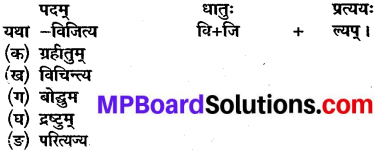
उत्तर:

Class 10th Sanskrit Chapter 11 MP Board प्रश्न 8.
अधोलिखितपदानां सन्धिविच्छेदं कृत्वा सन्धिनाम लिखत (नीचे लिखे पदों के संधिविच्छेद करके संधि का नाम लिखिए-)
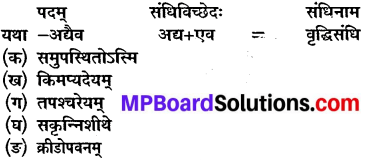
उत्तर:

Class 10 Sanskrit Chapter 11 Solutions MP Board प्रश्न 9.
अधोलिखितपदानां समासविग्रहं कृत्वा समासनाम लिखत (नीचे लिखे पदों के विग्रह कर समास का नाम लिखिए)
(क) धर्मचर्या
(ख) क्रीडोद्यानम्
(ग) विनोदसामग्री
(घ) लोकयात्रा
(ङ) महाराजः
उत्तर:

Class 10 Sanskrit Chapter 11 Hindi Translation प्रश्न 10.
रेखाङ्कितसंज्ञाशब्दानां स्थाने सर्वनामशब्दानां प्रयोगं कुरुत (रखाङ्कित शब्दों के स्थान पर सर्वनाम शब्दों का प्रयोग कीजिए-)
(क) राहुलः शाक्यवंशधरः आसीत्। (राहुल शाक्यवंशधर था।)
उत्तर:
कः शाक्यवंशधरः आसीत्? (कौन शाक्यवंशधर था?)
(ख) यशोधरा सिद्धार्थस्य पत्नी आसीत्। (यशोधरा सिद्धार्थ की पत्नी थी।)
उत्तर:
का सिद्धार्थस्य पत्नी आसीत्? (कौन सिद्धार्थ की पत्नी थी?)
(ग) सिद्धार्थस्य पिता शुद्धोदनः आसीत्। (सिद्धार्थ के पिता शुद्धोदन थे।)
उत्तर:
कस्य पिता शुद्धोदनः आसीत्? (किसके पिता शुद्धोदन थे?)
(घ) सिद्धार्थः परिव्राजकः अभवत्। (सिद्धार्थ संन्यासी बना।)
उत्तर:
कः परिव्राजकः अभवत्? (कौन संन्यासी बना?)
(ङ) सिद्धार्थः राहुलस्व जनकः आसीत्। (सिद्धार्थ राहल के पिता थे।)
उत्तर:
सिद्धार्थः कस्य जनकः आसीत्? (सिद्धार्थ किसका पिता था?)
Sanskrit Chapter 11 Class 10 MP Board योग्यताविस्तार –
सिद्धार्थस्य विस्तृतजीवनचरितम् अन्विष्य लिखत।
(सिद्धार्थ का विस्तृत जीवन चरित्र ढूँढकर लिखिए
अस्य नाट्यांशस्य सामूहिकम् अभिनयं कुरुत।
(इस नाट्यांश का सामूहिक अभिनय कीजिए।)
महाभिनिष्क्रमणम् पाठ का सार
प्रस्तुत पाठ सिद्धार्थ के जीवन का अंश है। इस पाठ में उनके संन्यास लेने से पूर्व की कथा है। जब उन्होंने शरीर की विभिन्न अवस्थाएँ-जरा, रोग व मृत्यु-देखी तो उन्हें इस संसार से विरक्ति हो गई और उन्होंने गृहत्याग कर संन्यास ले लिया था। इससे पूर्व उनकी जो मानसिक स्थिति थी, उसका वर्णन इस पाठ में किया गया है।
महाभिनिष्क्रमणम् पाठ का अनुवाद
1. सिद्धार्थः-(स्वगतं चिन्तयन्) हन्त। कियती विडम्बना मानवशरीरस्य। वासन्तिकं यौवनं, कुसुमसुकुमारमनोहरा देहसम्पत्, किमिदं सर्वं स्थिरम्? किं यशोधरायाः यौवनमचलम्? किं जरा व्याधिर्मत्युश्य मदीया अन्तः पुरपरिचारिकाः कदापि नाक्रमिष्यन्ति? किमेता न जानन्ति यद्यौवनं चपलम्? जरा रूपं नाशयिष्यति?
यशोधरा-कुमार! कुमार, किं चिन्तयति भवान्?
सिद्धार्थः :
न किमपि यशोधरे! उद्विग्नमिव मे चेतः। इत एहि अत्रोपविश। इदमेव विलोक्य आश्चर्यम् अनुभवामि यशोधरे यत् वयं मनुष्याः प्रतिदिनं ग्रसन्ती मृत्युराक्षसीं जानन्तोऽपि न शोचामः । अद्य न जाने मदीये हृदये कश्चन् वक्ति यत् जरां व्याधि मृत्यु च विजित्यैव मनुष्यस्य यौवनं विलासश्च शोभते। नृत्यसङ्गीत-वादिषु नानुरञ्ज्यामि, न च तुष्यामि क्रीडाद्यानद्रमः, प्रेक्षागृहपञ्जरैः, स्नानगृहनिर्झरैः।
यशोधरा-तर्हि कुमार! किं व्यवसीयते भवता?
Sanskrit Class 10 Chapter 11 Solutions MP Board सिद्धार्थः :
इदभेव वाञ्छामि यशोधरे, यदधुना परिवाजको भूत्वा मृत्योर्निग्रहाय तपश्चरेयम्।
शब्दार्थाः :
स्वगतम्-मन में-Inward, in heart; उद्विग्नम् -दुखी-grieved; ग्रसन्तीम्-खाती हुई-swallowing; शोचामः-(हम) सोचते हैं-feel sorrowful; नदीये-मेरे-mine; विजित्यैव-जीतकर ही-on getting victory; नानुरज्यामि-प्रसन्न नहीं होता हूँ-do not feel delighted; प्रेक्षागृहपज्जरैः-नाट्यशाला के पात्रों को-actors of theatre.
अनुवाद :
सिद्धार्थ-(मन में सोचते हुए) आह! मानव शरीर की यह कैसी विडंबना है। वसन्त की तरह जवानी, फूल की तरह कोमल और सुन्दर शरीर क्या ये सब स्थिर हैं? क्या यशोधरा का यौवन अचल है? क्या बुढ़ापा, रोग और मृत्यु मेरे अन्तःपुर की सेविकाओं पर कभी आक्रमण नहीं करेंगे? क्या ये नहीं जानती हैं कि यौवन चंचल है? बुढ़ापा रूप को नष्ट कर देगा?
यशोधरा-कुमार! कुमार, आप क्या सोच रहे हैं?
Mp Board Class 10th Sanskrit Chapter 11 सिद्धार्थ :
यशोधरा! कुछ नहीं। मेरा मन दुखी सा हो रहा है। यहाँ आजो, यहाँ बैठो। यशोधरा, यही देखकर मुझे आश्चर्य हो रहा है कि हम मनुष्य प्रतिदिन खाती हुई मृत्यु रूपी राक्षसी को जानते हुए भी नहीं सोचते हैं। आज न जाने मेरे मन में कोई कह रहा है कि बुढ़ापा, रोग और मृत्यु को जीतकर ही मनुष्य का यौवन और विलास शोभा पाता है। नृत्य-सङ्गति, बाजे आदि मुझे प्रसन्न नहीं कर रहे और न ही उद्यान, पेड़ों से नाट्यशाला के पात्रों से और स्नानगृह के झरनों के खेल से मैं खुश हूँ।
यशोधरा ;
तो कुमार। आपको क्या चाहिए?
सिद्धार्थ :
यशोधरा! मैं यही चाहता हूँ कि अब संन्यासी बनकर मृत्यु को पराजित करने के लिए तप करूँ!
Mp Board Solution Class 10 Sanskrit English :
Old age, diseases and death bring about decay in beauty and youth-youth is flickering-old age disfigures beauty-nothing appeals an aggrieved soul-wish to get sanyasa (liberation) to defeat death through penance.
2. यशोधरा-किमिदं भाषते भवान्? परिव्रज्यायाः नायं समयः। कतिपयमासेभ्यः पूर्वमेव तु भवान शाक्यवंशधरस्य कुमार-राहुलस्य जनकः सञ्जातोऽस्ति। आगच्छतु भवान् अद्य कुमार-राहुलस्य अभिनिष्क्रमणसंस्कारः।
सिद्धार्थः :
न किमपि इच्छामि यशोधरे। अद्यैव प्रव्रज्यायै अनुमतिं ग्रहीतुं महाराजस्य सौधमुपसमि। अथैव प्रव्रज्यायै अनु। यशोधरा-(तारस्वरेण) कुत्र प्रयाति कुमारः? कुमार! कुमार!
(दृश्यपरिवर्तनम्) सिद्धार्थः-आर्य! अभिवादये। शुद्धोदनः-सिद्धार्थ! शाक्यवंशधरो भव।
सिद्धार्थः :
आर्य! अद्य एकामनुज्ञां ग्रहीतुं समुपस्थितोऽस्मि। अहं जानामि यदाजन्म महाराजस्य मह्यं किमप्यदेयं नास्ति।
शुद्धोदनः :
नि:शङ्कं ब्रूहि सिद्धार्थ! मम प्राणा अपि त्वदधीनाः कुमार।।
शब्दार्था: :
प्रव्रज्यायै-संन्यास के लिए-for assuming sanyasa; सौधमुपसमि-महल में जाऊँगा-.go to the palace; तारस्वरेण-ऊँचे स्वर में-loudly;प्रयाति-जाता है-goes; त्वदधीनाः-तुम्हारे अधीन-render under control.
अनुवाद :
सिद्धार्थः-यह आप क्या कह रहे हैं? यह समय संन्यास का नहीं है। कुछ महीने पूर्व ही तो आप शाक्यंवशधर कुमार राहुल के पिता बने हैं। आप आइए, आज कुमार राहुल का अभिनिष्क्रमण संस्कार है।
सिद्धार्थ :
यशोधरा! कुछ भी इच्छा नहीं है। आज ही संन्यास के लिए अनुमति लेने महाराज के महल में जाऊँगा। आज ही संन्यास के लिए। यशोधरा-(ऊँचे स्वर से) कुमार आप कहाँ जा रहे हैं? कुमार! कुमार!
(दृश्य बदलता है)
सिद्धार्थ :
आर्य! अभिवादन करता हूँ। शुद्धोदन-सिद्धार्थ! शाक्यवंश के धारक (रक्षक) हो।
सिद्धार्थ :
आर्य! आज एक आता लेने के लिएपस्थित हुआ हूँ। मैं जानता हूँ कि जब मेरा जन्म हुआ है, महाराज का मेरे लिए कुछ भी अदेय नहीं है।
शुद्धोदन :
निःसंकोच होकर कहो सिद्धार्थ! मेरे प्राण भी तुम्हारे अधीन हैं, कुमार!
English :
Yashodhra advises him not to take the drastic step Siddhartha is adamant. Siddhartha approaches his father to seek his permission.
3. सिद्धार्थः-महाराज! सुबहु मया विचारितं प्रजानां लोकयात्रार्थम्। अधुना शोकमृत्युभयानां निग्रहाय तपश्चिकीर्षामि। प्रव्रज्यायै अनुज्ञातुमर्हति मां महाराजः।
(कोलाहलो वर्धते, आश्रचर्यम्, आश्चर्यम् इति ध्वनयश्च) शुद्धोदनः-कुमार सिद्धार्थ! किमिदं व्यवसितं त्वया? न हि कालस्ते प्रव्रज्यां ग्रहीतुम्। प्रथमे वयसि चलायां मतौ धर्मचर्या बहु दोषा भवति। मया हि तव कुतूहलार्थं क्रीडोद्याने सर्वापि विनोदसामग्री समुदपस्थापिता। चित्रं मनोज्ञेऽपि विषये तव रतिर्न जायते।
सिद्धार्थ :
आर्य! जरा व्याधिश्च मृत्युश्च यदि न स्युस्तर्हि मम मनोज्ञेषु विषयेषु रतिर्भवत्। असंशयं मृत्युरिति जानतोऽपि यस्प हृदि रागो जायते तस्य चेतना लोहमयीमेव उत्प्रेक्षे।
शब्दार्थाः :
सुबहु-अच्छी तरह से-from all angles; चिकीर्षामि-इच्छा करता हूँ-wish for; व्यवसितम्-संङ्कल्प-resolve.
अनुवाद :
सिद्धार्थः-महाराज! अच्छी तरह से मेरे द्वारा प्रजा की लोकयात्रा का विचार किया गया। अब शोक व मृत्यु के भय पराजित करने के लिए तप की इच्छा करता हूँ। महाराज, जाप मुझे संन्यास की आज्ञा दे, (शोर बढ़ जाता है, आश्चर्य है, आश्चर्य है, ऐसी ध्वनि होती है।)
शुद्धोदन :
कुमार सिद्धार्थ! क्या वह तुम्हारा सङ्कल्प है? यह समरः तुम्हारे संन्यास लेने का नहीं है। प्रथम आयु में चलते हुए विचार में धर्माचरण बहुत दोषपूर्ण होता है। मेरे द्वारा ही तुम्हारे मनोरंजन के लिए क्रीड़ास्थल में सभी मनोरंजन की सामग्री लाई गयी थी। चित्र भी तुम्हारे मन और बुद्धि के विषयों पर अनुराग उत्पन्न नहीं कर सके।
सिद्धार्थ :
आर्य! बुढ़ापा, रोग और मृत्यु यदि न होते तो मेरे मन-मस्तिष्क के विषयों पर अनुराग होता। संशय रहित, मृत्यु है, यह जानकर भी जिसके मन में राग उत्पन हो, उसका भन लोहे के समान होगा।
English :
Siddhartha expressed his desire to perform penances. The king advised him against his decision. He had arranged recreational facilities in his son’s palace. Siddhartha is hell bent on encountering old age, diseases and death.
4. शुद्धोदनः-कुमार! कस्त्वामेदं दोधितवान्? तवदं सुकुमारं वयः प्रसन्नसुन्दरं च वपुः किं प्रव्रज्यायै भगवता सृष्टम्? नायं कालस्तव तपोवनाश्रयस्य। गच्छ क्रीडोपवनम्। अनुभव नृत्यवादित्रविनोदम्।
सिद्धार्थः :
कथमहं चेतनां वञ्चयेयमार्य। यदि भवान्मे प्रतिभूर्भवति यन्मम जीवनं मरणाय न सृष्टमस्ति, मम शरीरं रोगेभ्यः सर्वदा मुक्तं स्यात्, मम यौदलं च जरा न कदाप्याक्षिपेत, तर्हि अहं तपोवनं न श्रयिष्ये।
सूत्रधारः :
संसारस्य निःसारता, जनन-मरण-चक्रस्य वन्धनं, मानुषी गतिः, र्वमिदं विचिन्त्य सिद्धार्थों व्यरञ्ज्यत लोकयात्रातः। सकृन्निशीथ तेन व्यवगितं यत्सर्वमिदं प्रपञ्चं परित्यजय जननमरणयोः पारं द्रष्टुं स तपस्तप्स्यति, साधनां विधास्यति, जीवनरहस्यं बोद्धं प्रयतिष्यते। (इति निष्क्रान्तः सर्वे)
शब्दार्थाः :
सष्टम-बनाया है-Created; वञ्चयेयम्-धोखा दूँगाँ-deceive; आक्षिपेक्-चढ़े-overrule; श्रयिष्ये-आश्रय ग्रहण करूँगा-seekshelter; निशीथे-अधी-रात में-at midnight; व्यवसितम्-निर्धारित कर-resolved;बोद्धम्-जानने के लिए-toknow; प्रतिभूः-जमानत, प्रमाण-evidence.
अनुवाद :
शुद्धोदन-कुमार! यह तुम्हें किसने बताया? तुम्हारी यह कोमल आयु और प्रसन्न व सुन्दर शरीर क्या संन्यास के लिए भगवान द्वारा बनाई गई है? यह समय तुम्हारे वन में आश्रय लेने का नहीं है। अपने क्रीडाग्रह में जाओ। नृत्य-संगीत आदि से मनोरञ्जन करो।
सिद्धार्थ :
आर्य! मैं अपने मन को कैसे धोखा दूं? यदि आप मुझे प्रमाण देते हैं कि मेरा जीवन मरने के लिए नहीं बना है, मेरा शरीर रोग से सदा मुक्त रहेगा, मेरी जवानी पर कभी बुढ़ापा नहीं चढ़ेगा, तो मैं तपोवन का आश्रय नहीं लूँगा।
सूत्रधार :
संसार की सारहीनता, जन्म-मरण के चक्र का बन्धन मनुष्य की गति, यह सब सोचकर सिद्धार्थ विरक्त हो कर लोकयात्रा को चला गया। ठीक आधी रात में उसके द्वारा निर्धारित करके कि यह सब दिखावा त्याग कर जन्म-मरण के पार देखने के लिए, वह तप करेगा, साधना करेगा और जीवन रहस्य जानने का प्रयास करेगा। (सब निकल जाते हैं।)
English :
The king asked the prince to return to the palace and enjoy himself.
The Prince rejected the king’s advice-he realised the futility of earthly pleasures.


